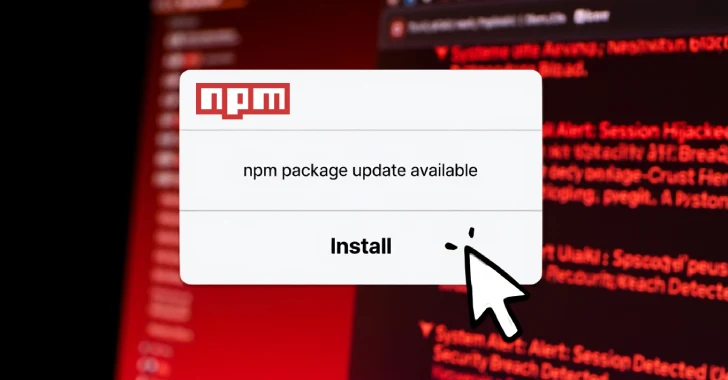
Malware Injected into 6 npm Packages After Maintainer Tokens Stolen in Phishing Attack
Unmasking the npm Supply Chain Attack: Stolen Tokens and Malicious Packages
The integrity of the software supply chain is a cornerstone of modern application development. When this chain is compromised, the ripple effects can be catastrophic, impacting countless projects and users. Recently, cybersecurity researchers unveiled a critical supply chain attack targeting popular npm packages, a stark reminder of the persistent threats developers face. This incident, originating from a sophisticated phishing campaign, saw maintainer tokens stolen and subsequently leveraged to inject malicious code directly into widely used npm libraries.
This report delves into the specifics of this npm supply chain compromise, analyzing the attack vector, its implications, and, most importantly, providing actionable remediation strategies to safeguard your development ecosystem. Understanding these threats is not merely theoretical; it’s essential for maintaining robust security posture in an increasingly interconnected digital landscape.
The Phishing Vector: A Precursor to Supply Chain Compromise
The genesis of this particular attack was a well-executed phishing campaign. Unlike traditional phishing attempts that target end-users with generic lures, this campaign was specifically engineered to ensnare project maintainers of popular npm packages. The objective was clear: acquire their npm authentication tokens. These tokens, once captured, provide attackers with direct access to publish new versions of packages under the legitimate maintainer’s identity.
The success of such phishing operations often hinges on their ability to mimic legitimate communication channels and exploit trust. Developers, constantly interacting with various platforms and tools, can fall victim to highly convincing imitations of official npm or GitHub communications. Once a maintainer unknowingly divulged their token, the adversary gained an almost unfettered ability to manipulate the associated packages.
Malicious Injections: When Trusted Code Turns Treacherous
Having acquired the npm tokens, the attackers bypassed traditional development workflows. Crucially, they did not engage in source code commits or pull requests on the packages’ respective GitHub repositories. Instead, they directly published malicious versions of the packages to the npm registry. This method is particularly insidious because it circumvents standard code review processes and relies solely on the compromised publishing credentials.
This approach highlights a critical vulnerability in the trust model surrounding package registries. If the publishing mechanism itself is compromised, the integrity of the hosted packages becomes inherently questionable, regardless of the security of the underlying source code repository. The malicious code, once published, would then be automatically downloaded and integrated into any project that lists the affected packages as dependencies, potentially propagating malware across a wide array of applications.
Illustrative Reference: CVE-2023-XXXXX (Placeholder)
While a specific CVE number associated with this broader incident of token theft and malicious injection may not yet be broadly published, the underlying risk aligns with vulnerabilities that exploit compromised credentials or inadequate supply chain security. For example:
- CVE-2023-XXXXX (Placeholder for Credential Theft): Represents cases where attacker-obtained credentials lead to unauthorized access and malicious activity.
- CVE-2023-XXXXY (Placeholder for Supply Chain Integrity Compromise): Encompasses vulnerabilities where the integrity of software distribution channels is compromised.
It is imperative for the cybersecurity community to push for specific CVEs where appropriate, to allow for standardized tracking and mitigation efforts.
Remediation Actions: Fortifying Your npm Ecosystem
Protecting against such sophisticated supply chain attacks requires a multi-layered defense strategy. For developers, organizations, and maintainers, the following actions are crucial:
- Implement Multi-Factor Authentication (MFA) for npm and GitHub Accounts: This is arguably the single most effective deterrent against credential theft. Even if an attacker obtains your password or token, MFA prevents unauthorized access without the second factor.
- Regularly Rotate npm Tokens: Treat npm tokens like sensitive credentials and rotate them periodically. Many organizations recommend quarterly rotation.
- Utilize Granular Token Permissions: Where possible, generate npm tokens with the least privileges necessary for their specific task (e.g., publish-only tokens for CI/CD pipelines).
- Scrutinize Package Dependencies: Employ supply chain security tools to vet new and existing dependencies. Look for sudden, unusual changes in package versions or maintainers.
- Implement Package Integrity Checks: Use tools that verify the integrity of downloaded packages against known good hashes or signatures.
- Educate Developers on Phishing Awareness: Conduct regular training sessions to help developers identify sophisticated phishing attempts, particularly those targeting development tools and platforms.
- Monitor npm Package Activity: Subscribe to alerts for critical npm packages your projects depend on. Monitor for unexpected updates or suspicious activity.
- Use npm Audits and Dependency Scanners: Regularly run
npm auditto identify known vulnerabilities in your dependencies. Integrate third-party dependency scanning tools into your CI/CD pipeline. - Consider Private npm Registries: For critical internal applications, consider hosting your own private npm registry with stricter access controls and monitoring.
Tools for Enhanced Supply Chain Security
Leveraging the right tools can significantly enhance your ability to detect and prevent supply chain attacks.
| Tool Name | Purpose | Link |
|---|---|---|
| Snyk | SCA, SAST, DAST for identifying vulnerabilities in dependencies. | https://snyk.io/ |
| Dependabot | Automated dependency updates and vulnerability alerts within GitHub. | https://docs.github.com/en/code-security/dependabot/dependabot-overview/about-dependabot |
| OWASP Dependency-Check | Identifies project dependencies and checks for known vulnerabilities. | https://owasp.org/www-project-dependency-check/ |
| npm audit | Built-in npm command for auditing dependencies for vulnerabilities. | https://docs.npmjs.com/cli/v9/commands/npm-audit |
| Supply-chain Levels for Software Artifacts (SLSA) | Framework of standards and controls to prevent tampering and enhance integrity. | https://slsa.dev/ |
Conclusion: A Call for Vigilance in Software Supply Chain Security
The incident involving malware injection into npm packages via stolen maintainer tokens underscores the critical importance of a proactive and vigilant approach to software supply chain security. As development ecosystems become more interconnected, the attack surface expands. Organizations and individual developers must recognize that trust in third-party components is earned through rigorous security practices, not assumed.
By implementing robust authentication mechanisms, regularly auditing dependencies, educating teams on social engineering tactics, and leveraging available security tools, we can collectively build a more resilient software development landscape. The fight against supply chain attacks is ongoing, and continuous adaptation and vigilance are our strongest defenses.





